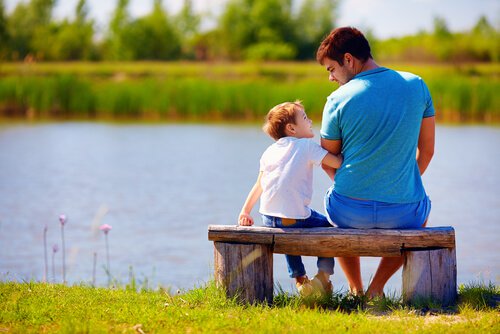Custody Options and their Effect on Children

A divorce is an event that can be very emotional and create mixed feelings. In this context, legal psychology pays extra attention to this kind of process and how they affect children. When a couple divorces, there are many questions regarding their children. Who are they going to stay with? When will they see the other parent? In short, how to choose between custody options?
In terms of shared or sole custody, this is something that a psychologist can easily solve: is shared custody the best option? Can sole custody have no impact on the child? Are there well-being differences between both options?

Custody options: shared or sole custody
Tejeiro and Gómez (2011) conducted a study titled Divorcio, custodia y bienestar del menor: una revisión de las investigaciones en Psicología (In English: Divorce, custody, and the child’s well-being: a revision of psychological investigations). Their research found that there are differences in well-being between children in shared or sole custody.
Both authors pinpoint what Bauserman (2002) stated after selecting 33 studies with the best parametrical assets: children in shared custody were better adjusted than those in sole custody of a parent. He compared how children in shared custody fared between those with still married parents.
Some of the differences between custody options are:
- Parents are more involved when sharing custody.
- There was less depression in families with shared custody.
- Children in sole custody had more emotional issues.
- There were more sibling rivalry and more self-esteem in children in shared custody.
- There was a sensation of feeling rejected by their sole guardian.
- Children had a better concept of themselves, and better locus of emotions and relationship with their parents in shared custody.
However, other studies found that either custody options affected children’s emotional health.

The effects of shared custody on the family
Shared custody seems the best option not only for children, but for their divorcing parents, as well. This is the opinion of Marín Rullán (2015), who found that low levels of discord and higher levels of communication relate a better relationship with parents and, thanks to this, both have higher levels of satisfaction than other parents.
The fighting between parents has a more negative effect on their children. Therefore, their well-being depends on how their parents get along. Even though people think that shared custody is the best for the child, it also means more contact between people and a deteriorated relationship. However, Tejeiro and Gómez studied this variable as well and found that shared custody made parents fight less.
Another concern in shared custody is forcing parents to see each other every now and then, and not being able to heal any open wounds. Studies suggest that this is just an unfounded fear. Thus, the distancing between both parents, as measured by Pearson and Thoennes (1990), tends to increase after two years, no matter the custody type.
What happens with these families 12 years later?
This is what Emery, Laumann, Waldron, Sbarra, and Dillon (2001) asked themselves when they decided to see what happened in families that had chosen shared or sole custody. There were more conflicts between parents during the latter. Among the many conclusions they reached, the most interesting one is that parents of children in sole custody weren’t interested in each other’s lives.
Likewise, these authors found that parents in shared custody made more changes in their lives and, therefore, in the child’s life, but that this didn’t mean more conflict between the parents. This related to aspects like flexibility and cooperation.

The impact on the minor’s adjustment to life
Bauserman, in his meta-analysis Child Adjustment in Joint-Custody Versus Sole-Custody Arrangements: A Meta-Analytic Review, measures the levels of adjustment in children in different custodians. Thus, the adjustment means:
- Behavioral adjustment. Behavior disorders.
- Emotional adjustment. Depression, anxiety, problems in locus control, self-concept, etc.
- Self-esteem.
- Family relations.
- Academic performance.
The fact that all of these categories were better in the child on shared custody than on the child in sole custody supports the theory that shared custody has a better impact in a child’s life.
Shared custody, beneficial and convoluted
After a complicated and painful process, people start doubting what the best option is. Perhaps, even if parents seem to have their best interest in giving their child a normal life, they don’t know how to manage shared custody.
In this context, Marín Rullán seems to be very clear on something: four factors can make it or break it. These are:
- Commitment and dedication, beyond what the court says.
- Supporting the other parent. Respecting the bond between the other parent and the child.
- Flexible distributions of responsibilities.
- Psychological characteristics. Being cooperative is a trait of empathetic people, less vulnerable, and with positive parental attitude.
In short, taking into account the experiences of parents and children, the question isn’t custody options. The question should be: how to give parents the skills they need to achieve a good shared custody?
All cited sources were thoroughly reviewed by our team to ensure their quality, reliability, currency, and validity. The bibliography of this article was considered reliable and of academic or scientific accuracy.
- Bauserman, R. (2002) Child Adjustment in Joint-Custody Versus Sole-Custody Arrangements: A Meta-Analytic Review. Journal of Family Psychology, 16(1), 91-102.
- Emery, R., Laumann, L., Waldron, M., Sbarra, D. & Dillon, P. (2001). Child Custody Mediation and Litigation: Custody, Contact, and Coparenting 12 Years After Initial Dispute Resolution. Journal of Consulting and Clinical Psychology, 69(2), 323-332.
- Marín Rullán, M. (2015). La influencia de las actitudes parentales sobre el bienestar del menor y la elección preferente de la custodia compartida: una disertación. Psicopatología Clínica, Legal y Forense, 15, 73-89.
- Tejeiro, R. y Gómez, J. (2011) Divorcio, custodia y bienestar del menor: una revisión de las investigaciones en Psicología. Apuntes de Psicología, 29(3), 425-434.
This text is provided for informational purposes only and does not replace consultation with a professional. If in doubt, consult your specialist.








